If you’re in the market for a new vacuum cleaner, you might well find yourself choosing between Dyson vs Shark. These are probably the two most respected and popular vacuum brands on the market right now, and certainly the models we tend to rate the highest here at TechRadar. Both brands crop up repeatedly in our general best vacuum cleaners ranking, as well as our best cordless vacuum roundup. Now’s a great time to buy, too, because the Black Friday vacuum deals are starting to ramp up, with offers on both brands already available.
Both Dyson and Shark make plenty of great vacuums, and are well worth checking out. However, depending on what you’re looking for, one might be a better choice over the other.
In terms of brand focus, Dyson is all about engineering. It has invested plenty of time and resources into its vacuums, and it’s continuously working to hone its designs to improve efficiency, suction power and battery life. Today’s best Dyson vacuums tend to be meticulously crafted, more high-tech, but more expensive, as a result.
Shark has a much wider, more varied range. Its models are often less tech-focused and instead spotlight usability – a great example is the forward-bending wand for cleaning under furniture. Today’s best Shark vacuums also tend to come in at a lower price compared to Dyson models, delivering good value for money.
And there are plenty more subtle differences worth considering, too. Read on for my in-depth Shark vs Dyson vacuum comparison.
Shark vs Dyson: range
- Dyson’s range mainly comprises cordless stick vacuums
- Shark has a much wider selection of vacuum types
- Dyson’s range is fairly streamlined, Shark’s is wider and confusing
Dyson has a fairly straightforward vacuum range. Its main focus, and arguably what it’s still best known for, is its cordless stick vacuums. Alongside the main model, you’ll find alternatives with words such as “Complete”, “Absolute” and “Animal” on the end. Generally speaking, these will be the same vacuum, but with a different array of tools included, or perhaps in a different colorway.
At time of writing, the oldest model in the official lineup is the Dyson V8, which launched in 2016. It looks roughly like the rest of the Dyson cordless range, but is less powerful, with fewer fancy features.
That’s followed by the Dyson Cyclone V10, which hit the market in 2018. This was the model to introduce the “in-line configuration” seen on all subsequent stick vacs, which saw the motor, bin and cyclone array positioned in a straight line, to maximize suction power. See how it compares to its predecessor in our Dyson V8 vs V10 explainer.
In 2019, we got the Dyson V11. This introduced the LCD screen for alerts and information, where previous models used LED indicator lights. Our Dyson V10 vs V11 explainer has more detail.

Next to launch in 2021 was the new flagship, the Dyson V15 Detect. This model added dirt detection capabilities and a floorhead featuring a laser to highlight hidden dust. See how it compares to the previous flagship in our Dyson V11 vs V15 face-off. There’s also a V15s Detect Submarine, which is a cordless stick vacuum whose standard floorhead can be swapped out for an optional wet cleaner floorhead.
That same year, Dyson launched the V12 Detect Slim, a kind of in-between model that’s a slightly more advanced, but smaller and lighter, version of the V15.
At time of writing, the latest and greatest Dyson vacuum is the Dyson Gen5detect. This introduces a new motor and battery, offering longer runtimes and greater power (find out more about the differences between Gen5detect and V15 Detect).
Dyson also has one corded upright model, the Dyson Ball Animal, currently on its third-gen iteration. The other outliers include a robot vacuum called the Dyson 360 Vis Nav, and a wet cleaner called the Dyson WashG1.
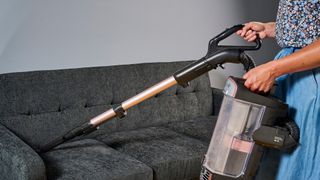
Moving on to Shark, the range is much less straightforward. There are dozens and dozens of models, often sporting very similar names, with models appearing and disappearing on a regular basis. It’s fairly common to find that a model will have a different name and product code depending on the country you’re in. Shark offers a much broader selection of model types, too: as well as cordless stick vacuums, there are corded stick vacuums, lots of upright vacuums, car vacuums, a range of robot vacuums, and plenty of wet floor cleaners as well.
I won’t get into all your options, because I don’t have a spare year, but three of Shark’s key ranges are Stratos, Detect Pro and PowerDetect. All have various different types of vacuum in their ranges, but I’ll focus on the cordless stick vacuum options.
Stratos is the oldest and least advanced of the three. The Stratos Cordless Stick Vacuum offers powerful suction, but the payoff is that it’s a little heavier than the other two. My Shark Detect Pro vs Stratos comparison goes into more depth on the differences.
The Detect Pro range is a little newer. The Detect Pro Cordless Stick vacuum is lighter and a little less powerful than the Stratos, but adds a bunch of smart automation features, including the ability to adjust suction when it detects the floor is especially dirty.
PowerDetect is the newest Shark range at time of writing. The PowerDetect Cordless Stick vacuum is designed to combine the suction power of the Stratos vacs with the smarts of the Detect Pro vacs, and adds a few new features besides. Our Detect Pro vs PowerDetect explainer provides more detail on the differences between those two ranges.
Shark vs Dyson: design & usability
- Dyson vacuums offer better floorhead maneuverability
- Most Shark vacuums arrive with a bendable wand for cleaning under furniture
- Dyson models dock on a wall-mounted charger; Sharks can be stored freestanding
While there will be specific differences between particular models of vacuum you might be considering, there are a few generalizations that can be made regarding the performance and usability of Shark vacuums versus Dyson vacuums.
Let’s start with suction. Shark doesn’t release suction specs (and actually, figuring out how much suction a vacuum cleaner has is more complicated than you might imagine), but generally speaking, Dyson vacuums tend to have a more powerful maximum suction mode than Shark models, especially at the top end of the range.
However, on test, we’ve generally been very impressed with the cleaning power offered by both brands. Most Shark and Dyson vacuums we’ve tested have performed well in our cleaning tests, which include both fine dust and larger debris. For most people, either brand will offer plenty good enough suction for daily cleans. However, if you’re dealing with high levels of dirt, you might be better off with a Dyson.
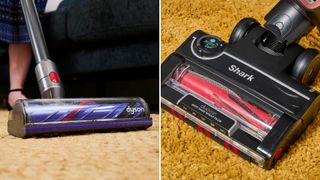
Now, let’s look at maneuverability. Dyson’s cordless vacuums really shine here – the floorhead can pivot smoothly any which way, easily moving around furniture and getting into nooks and crannies without issue.
Shark’s cordless stick vacuums offer decent maneuverability, but fall short of being as nimble as those from Dyson. However, one area where Shark holds the trump card is with its flexible wands. Most Shark stick vacuums feature a button on the back of the wand, which, when pressed, allows the wand to fold forward. This enables you to vacuum easily under furniture, without having to get down on the floor yourself.
Shark refers to this as MultiFLEX / Flexology – one of many confusing bits of brand jargon that you’ll need to navigate on your shopping journey. This Shark vacuum technologies guide should help you decipher things.
Note: Dyson now sells an accessory that adds very similar functionality to its own stick vacuums. Find out more in my Dyson vacuum tools guide.

A benefit of this foldable design is that it enables most of Shark’s cordless vacuums to be stored freestanding when they’re not in use, seeing the wand released and the motor and heandle folding down next to the floorhead. In contrast, Dyson cordless vacuums are designed to be stored on a wall-mounted charging dock.
A minor downside to Shark’s freestanding solution is that it requires the floorhead to lock in place at a right angle to the vacuum wand. It’s easy to release by pressing gently on the floorhead with your foot, but can sometimes catch in the lock position during vacuuming, which is a little annoying. In contrast, Dyson’s floorheads just hang loose from the end of the wand.
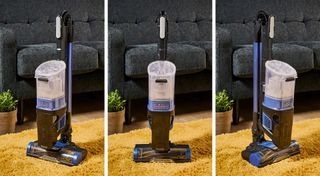
Both Dyson and Shark’s cordless models can be converted into handheld vacuums by removing the wand, and both arrive with a range of tools for detail cleaning tasks. The exact tools included will vary depending on the model and iteration, but we’ve been especially impressed with Dyson’s options, which include a fluffy floorhead designed especially for hard floors, and a hair-screw tool for pulling hair from furniture.
Speaking of which, anyone who has long hair, or lives with someone who does, will know how quickly it can build up on the brushroll of a vacuum’s floorhead. Both Shark and Dyson have taken steps in the design of their models to counter this and encourage hair straight into the bin. On test, we’ve been impressed with both brands’ anti-hair wrap technologies.
Shark vs Dyson: controls
- Newer Dyson models feature an LCD screen that provides complex information
- Shark vacuum controls tend to be more basic
Older options from both brands are operated using a trigger the needs to be continuously depressed while vacuuming, and both have changed to one-press buttons or switches in their newer models. The latter approach is much more comfortable when vacuuming for longer periods.
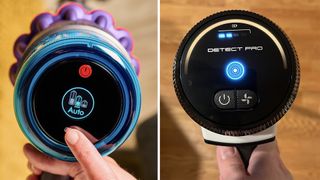
Shark vacuums tend to use indicator lights or illuminated icons to relay information about power mode or battery life to the user. It’s a similar situation with older Dyson models (the V8 and V10); but if you opt for a V11 or later, there’s an LCD screen that can display more detailed info. For instance, it will indicate in words/numbers exactly how long you have left in the current battery mode, and it prompt if any maintenance tasks are required. This screen is also used for real-time dust stats, but I’ll get into that in the “Special features” section.
Shark vs Dyson: battery life
- Battery life broadly in line: 40 mins for basic models, 60 mins for premium
- Dyson Gen5detect has a maximum runtime of 70 minutes
Specs for maximum battery life are based on use in the lowest power mode, and specifics vary by model. Broadly speaking, though, Shark and Dyson are roughly in line here. The older or cheaper options in each brand’s lineup will top out at around 40 minutes (still a decent amount of cleaning time), while more advanced Shark and Dyson vacuums offer a full hour from a single charge. However, the newest Dyson Gen5detect delivers a maximum of 70 minutes – that’s the longest battery life I’ve seen from any brand.
This isn’t without a payoff, though: the motor/battery part of the Gen5detect is noticeably heavy for a cordless stick vacuum. Also bear in mind that one vacuum’s lowest power mode isn’t necessarily the same as another’s in terms of suction. In boost/max modes, you can expect the battery to drain significantly faster on models from both brands.
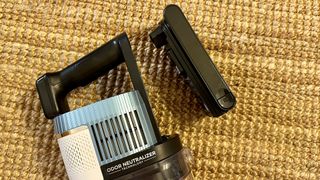
If you’re looking at the upper end of both ranges, both have “Auto” modes designed to intelligently adjust suction based on dirt levels (and other things) in order to deliver the most battery-efficient clean (more on this in the next section). Runtimes will naturally vary in this mode.
Both Dyson and Shark cordless vacuums tend to have swappable batteries, meaning you can purchase a backup and hot-swap to extend battery life if you wish. One benefit of Dyson over Shark is that if you pick a newer model, it will spell out exactly how much cleaning time you have left in the current battery mode. With Shark, you’re relying on indicator lights.
Shark vs Dyson: special features
- Both can adjust suction based on the level of dirt on the floor
- Dyson has better floorhead headlights, and real-time dirt data
- Shark has an optional auto-empty dock and odor neutralizer puck
Beyond standard cleaning power, the newer Shark and Dyson models also have several special features, the kind that you might not expect from a regular vacuum. In this section, I’m mostly talking about the Shark Detect Pro and PowerDetect cordless stick vacuums, and the Dyson V15 Detect and Gen5detect. Specifics vary by model, so double-check what’s included before you buy.
Perhaps the most useful special feature is automatic suction adjustment. Both brands have an “Auto” mode that will increase or decrease suction based on how much dirt the vacuum detects on the floor, and whether it’s being used on a hard floor or carpet. This means a low-effort cleaning session that maximizes battery life while still ensuring clean floors.
Dyson takes a slightly techier route with its automatic adjustment: it records particle volume and size, and provides real-time reports via the vacuum’s control screen, as well as a summary once you’re done. This is potentially interesting from a data point of view, but also helps you do a more thorough job. You can watch for the numbers to stabilize on the screen, at which point you can be sure that a particular patch of floor is clean and then move on. This feature is only available when using the main Digital Motorbar floorhead (not the fluffy one for hard floors), because that’s the one to feature the sensors.
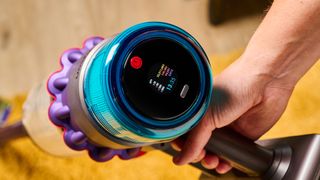
Shark’s most advanced vacuums won’t report back on what they’re sucking up, but they do have a range of extra detection properties that aren’t offered by Dyson. For example, as well as making adjustments based on floor type and dirt levels, they can sense when they’re cleaning near the edge of a room, where dust can gather, and amp up suction on the relevant side of the floorhead in response. They can also brighten or dim their headlamps depending on light levels in the area being cleaned.
Talking of which… On paper, the headlamps on both the Shark and Dyson sound similar, but they’re actually quite different.
Shark vacuums feature basic LED lights on their main floorhead that help brighten the path directly in front of the vacuum. Dyson’s lights appear on its “detect” models, taking the form of a precisely angled beam of laser light – the kind that’s safe for humans and animal eyes – designed to illuminate hidden dust on hard floors. The laser on the Gen5detect is brighter than that found on the V15 Detect, but both are significantly brighter than Shark vacuum headlamps.
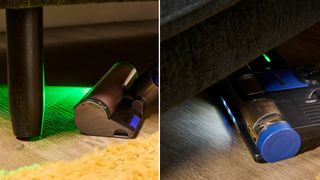
This laser is only found on the soft floorhead that’s designed specifically for hard floors (called the “Laser Fluffy” floorhead). It doesn’t appear on the main Motorbar floorhead, and as such can’t be used in conjunction with the automatic suction adjustment mode.
Shark has a couple of extra, unique features. With its newest vacuums, there’s the option of adding an auto-empty base. The idea is borrowed from robot vacuums, and is essentially a dock that features a larger dust bin. With the vacuum sitting on the dock, all the dust and debris whooshes out of the small onboard bin, through a sealed system and into the base. As well as saving on effort, it might be a particularly good choice for those who suffer from allergies because it means far less frequent manual emptying, and fewer chances for allergens to escape back into the air. This dock also charges the vacuum and provides somewhere to store it.
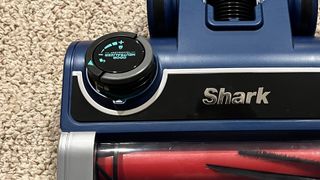
Another special feature that I haven’t seen anywhere is an an odor-neutralizing puck. This sits either in the floorhead or the auto-empty base, and is designed to stop the buildup of nasty odors – for example, if you’re vacuuming up a lot of dog hair on a regular basis. You can twist the puck to increase or decrease the neutralization levels. Contrary to popular belief, this isn’t designed to introduce an new scent into the air; just remove existing, bad smells. Many reviewers are big fans of this addition, but a handful think it’s a pointless gimmick.
Shark vs Dyson: price
- Generally, Shark vacuums are cheaper than Dyson vacuums
- Shark pricing is far less stable, so value for money varies
Using cordless stick vacuums for comparison, let’s look at how the two brands match up for price.
The oldest and cheapest model in the Dyson cordless vacuum lineup is the V8, which comes with a list price of $469.99 / £320 / AU$799 – although, at time of writing, could be found discounted everywhere to $329.99 / £229 / AU$499. The newest and priciest Dyson cordless vacuum is the Gen5detect, which costs $949.99 / £769.99 / AU$1,599 at list price. Dyson vacuum sales are more common than you might think, and there are always some decent price drops in the Black Friday Dyson deals.
Shark’s pricing is far more variable: the options change pretty regularly, as do the names and list prices for existing products. Discounts are offered regularly, and don’t always follow the expected patterns.
As an example, let’s look at the Detect Pro, which is the second-newest model in the Shark range. At time of writing, the vacuum-only model (without auto-empty base) has a list price of $379.99 / £349.99 / AU$599.99. In the US, that’s reduced to $199.99; but it has been out of stock for some time. In the UK, it’s down to £199.99, making it pretty much the cheapest cordless vacuum in the lineup, *****and in Australia’s full price (but the list price has dropped from the original $799.99)****. You see what I’m dealing with here.
However, broadly speaking, Shark vacuums tend to be cheaper than Dyson models, particularly when shopping at the top end of the range. Dyson’s most expensive vacuums are significantly more expensive than Shark’s most expensive vacuums. The Black Friday sales are a good time to shop, but it is actually possible to find deals pretty much year-round.
Dyson vs Shark vacuums: which should you buy?
Buy a Dyson vacuum if…
Buy a Shark vacuum if…
Services Marketplace – Listings, Bookings & Reviews
